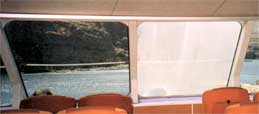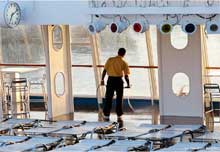Technical Information & FAQ's.
Sea-Thru™ is the worlds leading system for the renovation and protection of glass on Deep Sea vessels.

Why use Sea-Thru™ ?
Bad maintenance habits, damp conditions and chemical contamination are the main enemies of toughened glazing on ships. One or several of these factors can result in permanent staining and obscured glass.
Obscured exterior glazing in passenger amenity areas undermines passenger enjoyment. In premium cabins, Restaurants and busy Lido Decks in particular this is quite unacceptable.
The Sea-Thru™ Renovation & Treatment System gives you a cost effective solution to this age old problem.

‘Bad maintenance habits, damp conditions and chemical contamination are the main enemies of toughened glazing on ships’
How does Sea-Thru™ work?
The impact resistance, strength and safety features of toughened glass make it the automatic choice for use on all vessels. Unfortunately, the manufacturing process of toughened glass introduces changes in the crystalline structure of the finished material, making it more porous and vulnerable than ordinary glass. Consequently, a larger surface area of glass is exposed to the elements, providing more sites for atmospheric and chemical contamination. Once a cycle of chemical damage is established on this vulnerable surface it will become progressively worse. Therefore it is extremely common for ships' exterior glass to become so stained that conventional cleaning methods become ineffective.
The Sea-Thru™ non-stick Protective Treatment System is a one pack composite formulation containing an active multifunctional-branched co-polymer in a solvent system. The multifunctional-branched co-polymer proceeds, during the curing process, through a self-catalysed reaction with silonol groups present on the glass surface. A mono-molecular film results, bonded to the glass with exceptional resistance to marine contaminants.
Note: Sea-Thru™ non-stick Protective Treatment is progressive. Regular applications result in improved performance and increased durability…. after the line (mono-molecular film results, bonded to the glass with exceptional resistance to marine contaminants) in the section How does Sea-Thru™ work?
Technical Information Sheet
Sea-Thru™ Treatment imparts the following properties to treated surfaces.
Improved water repellence - Hydrophobic surface - Enhanced lubricity -Low coefficient of friction - Non-adherent - Non-oily surfaces. Reduction in the number of surface polar sites - Easier cleaning and improved appearance.
Water -Repellent Properties
A measure of Water-Repellent properties of a surface is determined by the contact angle on a droplet of water on the surface of the substrate. Paraffin is generally regarded as the most Water-Repellent of all liquids. Droplets of water placed on clean glass or metal surface have a relatively small contact angle <40°, which will be greatly increased by treating the surface. Paraffin (which is easy to remove) produces a contact angle of about 105°. The Sea-Thru™ Treatment System produces contact angles between 90° and 100°.
Coefficient of static friction
The coefficient of friction (glass slide on glass slide) on untreated and Sea-Thru™ treated slides is given by:
| Untreated | 0.9-1.0 |
| Sea-Thru™ treated | 0.2-0.3 |
This shows the enhanced lubricity.
Surface Resistivity
The surface resistivity shows the electrical insulating effect of the Sea-Thru™ Treatment System.
| On untreated glass slide | I x lO12 Ohms. |
| On treated glass slide | 1.2 x l012 Ohms. |
Critical Surface Tension
The critical surface tension of untreated and Sea-Thru™ treated glass slides are determined as:
| Untreated | Yc = mNm-1 Treated | Yc = mNm-1 |
Refractive Index and Light Absorption
The reactive index of a Sea-Thru™ Treatment is close to 1.4 at 25°C.
The mono-molecular film does not effect transmission of light in the visible range (400 - 760 Nm) - 99-100%.
In the UV range below 200 Nm the treatment does not transmit light.
In the N.I.R. above 2400 Nm the treatment does not transmit light.
HEAT RESISTANCE
The Sea-Thru™ Treatment shows excellent long-term resistance to high temperature. Dependent on atmospheric pollutants. Service temperatures up to 150°C or even short times at 250°C are feasible. Oxidation slowly attacks the system.
'Correct advice from the
outset on newbuilding vessels, ensures that good habits are established before problems arise.'


